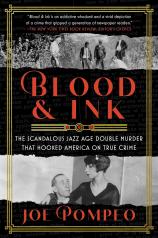Blood & Ink: The Scandalous Jazz Age Double Murder That Hooked America on True Crime
Review
Blood & Ink: The Scandalous Jazz Age Double Murder That Hooked America on True Crime
BLOOD & INK demonstrates that America’s obsession with true crime is nothing novel. The book follows the 100-year-old murders of Reverend Edward Hall, whose congregation at the Church of St. John the Evangelist in New Brunswick, New Jersey, was filled with the city’s well-heeled residents, and Eleanor Mills, a choir singer at the church. Both were married to other people. The clergyman’s wife, Frances Hall, was an heiress with ties to the wealthy Johnson & Johnson family, and Eleanor’s husband was a church sexton.
The two bodies were discovered on the morning of Saturday, September 16, 1922, on the edge of town, positioned side by side as if sleeping on the ground under a crabapple tree. Edward’s arm was behind Eleanor’s head, and her left hand was placed on his left thigh. Handwritten notes were found between them (later identified as love letters from Eleanor to Edward). Upon closer inspection, both had facial bullet wounds.
"While charting the meandering course of the years-long investigation into the murders, Pompeo weaves in fascinating details from the era..."
From the beginning, local officials bungled the investigation. Just hours after the grisly discovery, thousands of people turned out to view the bodies, parking on the side of the road and trampling over grass and the crime scene, while no one attempted to preserve the area. Meanwhile, newspapers caught wind of the story. They started covering it in what eventually would lead to a three-way fight to sensationalize the case, resulting in the birth of tabloid journalism. Vanity Fair correspondent Joe Pompeo weaves in the advent of this phenomenon, including the individuals and entities involved, and how this particular murder so heavily contributed to it with its lurid headlines and eye-catching photos.
The police struggled to solve the case partly because almost every witness or person of interest had ulterior motives for not wanting to tell the truth --- from late-night assignations to potential involvement in the crime to wanting to garner more media attention. Their stories changed constantly, which obviously hindered the investigation. Much of the book is devoted to how this played out across the years and impacted the focus of the case. Also threaded throughout is how the relationship between Edward and Eleanor eventually came to light and how the various parties reacted to this stunning revelation.
While charting the meandering course of the years-long investigation into the murders, Pompeo weaves in fascinating details from the era --- police patrolmen often didn’t have their own cars at that time, so the officers arriving at the scene had to catch a ride with a passing motorist; the beginnings of what we now call forensic science; how the media was more involved in solving crimes in the early 1900s; and an eyewitness dubbed the “Pig Woman,” who was so prominent in the news that she was on F. Scott Fitzgerald’s radar.
To wrap up his own investigation, Pompeo spends the last chapter of BLOOD & INK discussing the various theories that people have posited over the years about who might have committed the murders. He eventually weighs in with his own thoughts and acknowledges that there is no satisfying ending because the case remains unsolved. The last sentence reads: “But sometimes those are the greatest stories of all.” Not everyone will agree with this statement, but it certainly encapsulates the story.
Reviewed by Cindy Burnett on September 16, 2022
Blood & Ink: The Scandalous Jazz Age Double Murder That Hooked America on True Crime
- Publication Date: December 5, 2023
- Genres: History, Nonfiction, True Crime
- Paperback: 368 pages
- Publisher: William Morrow Paperbacks
- ISBN-10: 0063001748
- ISBN-13: 9780063001749



